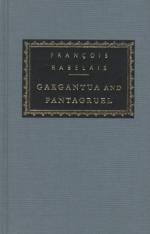himself to his principal study for three hours together,
or more, as well to repeat his matutinal lectures
as to proceed in the book wherein he was, as also to
write handsomely, to draw and form the antique and
Roman letters. This being done, they went out
of their house, and with them a young gentleman of
Touraine, named the Esquire Gymnast, who taught him
the art of riding. Changing then his clothes,
he rode a Naples courser, a Dutch roussin, a Spanish
jennet, a barded or trapped steed, then a light fleet
horse, unto whom he gave a hundred carieres, made
him go the high saults, bounding in the air, free
the ditch with a skip, leap over a stile or pale, turn
short in a ring both to the right and left hand.
There he broke not his lance; for it is the greatest
foolery in the world to say, I have broken ten lances
at tilts or in fight. A carpenter can do even
as much. But it is a glorious and praise-worthy
action with one lance to break and overthrow ten enemies.
Therefore, with a sharp, stiff, strong, and well-steeled
lance would he usually force up a door, pierce a harness,
beat down a tree, carry away the ring, lift up a cuirassier
saddle, with the mail-coat and gauntlet. All
this he did in complete arms from head to foot.
As for the prancing flourishes and smacking popisms
for the better cherishing of the horse, commonly used
in riding, none did them better than he. The
cavallerize of Ferrara was but as an ape compared
to him. He was singularly skilful in leaping
nimbly from one horse to another without putting foot
to ground, and these horses were called desultories.
He could likewise from either side, with a lance
in his hand, leap on horseback without stirrups, and
rule the horse at his pleasure without a bridle, for
such things are useful in military engagements.
Another day he exercised the battle-axe, which he
so dexterously wielded, both in the nimble, strong,
and smooth management of that weapon, and that in
all the feats practicable by it, that he passed knight
of arms in the field, and at all essays.
Then tossed he the pike, played with the two-handed
sword, with the backsword, with the Spanish tuck,
the dagger, poniard, armed, unarmed, with a buckler,
with a cloak, with a target. Then would he hunt
the hart, the roebuck, the bear, the fallow deer,
the wild boar, the hare, the pheasant, the partridge,
and the bustard. He played at the balloon, and
made it bound in the air, both with fist and foot.
He wrestled, ran, jumped—not at three
steps and a leap, called the hops, nor at clochepied,
called the hare’s leap, nor yet at the Almains;
for, said Gymnast, these jumps are for the wars altogether
unprofitable, and of no use—but at one leap
he would skip over a ditch, spring over a hedge, mount
six paces upon a wall, ramp and grapple after this
fashion up against a window of the full height of a
lance. He did swim in deep waters on his belly,
on his back, sideways, with all his body, with his
feet only, with one hand in the air, wherein he held




